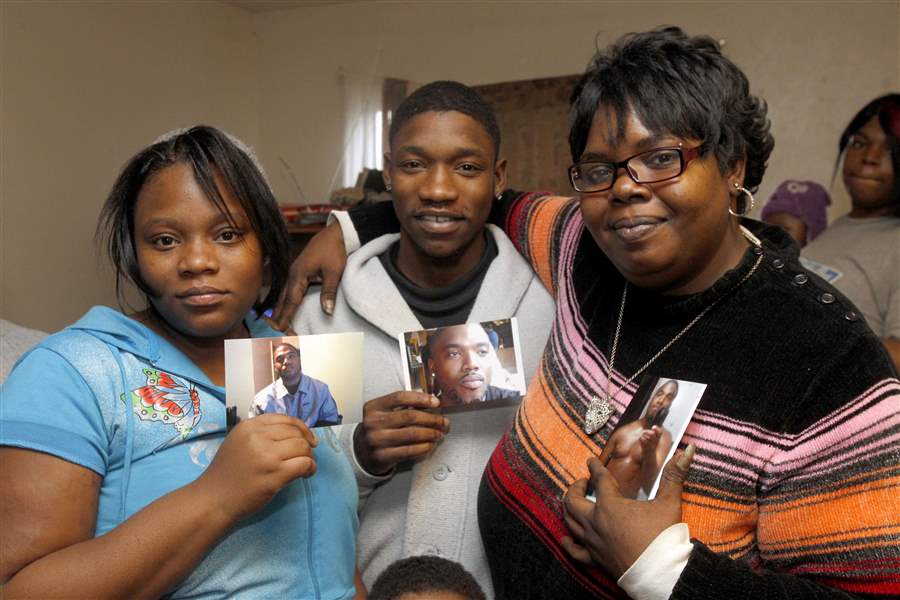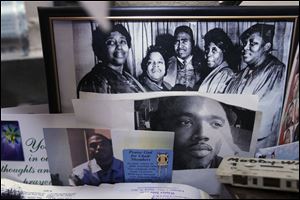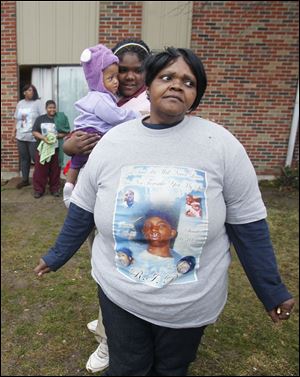
COMMENTARY
Another murder swept aside in Toledo steals a life, a dream
3/28/2013
Some of La’Sean Robinson’s siblings show pictures of the murder victim. From left are Latosha, James, and Lautricia Robinson, gathered in Toledo.
The Blade/Lori King
Buy This Image
This column by Jeff Gerritt, The Blade’s deputy editorial page editor, is one in a series of occasional editorials and columns on violence in the Toledo area, and possible solutions, that will appear in The Blade in 2013.

Some of La’Sean Robinson’s siblings show pictures of the murder victim. From left are Latosha, James, and Lautricia Robinson, gathered in Toledo.
A week before his 29th birthday in June, La’Sean D. Robinson told his oldest sister, Lautricia Robinson, 34, that he didn’t want to waste his life. They talked about how many black men didn't make it to 30.
Nearing that milestone, La’Sean planned to make changes. He wanted to get an education, maybe start a lawn and landscaping business, take care of his kids, and leave the streets.
On Sunday, June 3, wearing khakis and a button-up white shirt, he took his two children — La’Sean Robinson, Jr., 6, and 6-month-old daughter, Lala Robinson — and several nieces and nephews to Body of Christ Refuge Church on Euclid Avenue in East Toledo. La’Sean, who dropped out of Woodward High School in the 10th grade, had just been accepted to Owens Community College to take GED and college preparatory classes.
But a week later, early Sunday morning on June 10, La’Sean’s dreams ended in a friend’s Chrysler, where he was shot once in the head.
At 10:10 a.m., five or six hours after the shooting, a passer-by found his naked body, face down in a grassy North Toledo field at Bronson Avenue and Buckeye Street, where it had been dumped. La’Sean was last seen alive at the Ninja Club at about 4:30 a.m.
La’Sean Robinson became Toledo’s 15th homicide victim of 2012. Police arrested Charles C. McCuin, 20, in August. In court documents, police stated McCuin admitted accidentally shooting Robinson with a gun he bought on the street.
On Friday, McCuin pleaded guilty to involuntary manslaughter and tampering with evidence. He will be sentenced March 15 and faces up to 17 years in prison. Police had earlier charged McCuin with murder.
“We’re disappointed, but even if they gave him death, it wouldn’t bring back my brother,” La’Sean’s 27-year-old sister, LaQuanda Robinson, told me late Friday. “It’s in no one’s hands now but the Lord’s.”
You probably know little about La’Sean Robinson, or the 38 other people murdered in Toledo last year. Unlike the 20 children and six educators massacred in Newtown, Conn., their deaths didn’t make national headlines or spark a nationwide debate on gun control.
Nor did the 386 people killed in Detroit last year. Or the 506 in Chicago. Or the 331 in Philadelphia. Or the thousands of others killed on the streets of America’s great cities.
Most were black. Most were poor. Most were killed by handguns.

A photo shrine memorializes La’Sean Robinson, who was murdered June 10, 2012, on his 29th birthday. Charles C. McCuin pleaded guilty Friday in the slaying.
Ohio’s black homicide rate is more than four times the nation’s overall average. Nationwide, 83 percent of black victims are killed by guns.
These acts of murder — whether committed in Toledo, Chicago, or Detroit — are often so random and senseless that even old-school gangsters shake their heads. A 1-year-old child, Keondra Hooks, died last year after someone fired at least a dozen rounds into a central Toledo apartment. An 81-year-old woman, Fannie Mae Smith, was shot to death while watching television in her central Toledo home when someone fired through a window.
The slaughter in the nation’s central cities — especially of young African-American men — has continued for decades. Their families and friends suffer as much as those of any homicide victim. Anyone who has attended a funeral on Chicago’s South Side, or on Detroit’s East Side, or in central Toledo, and witnessed the nearly bottomless outpouring of grief, knows that life is not cheap there, as is often claimed by people who know little about such places.
In America’s bleeding cities, easy access to guns and an unspoken hopelessness that can turn into a dangerous nihilism often become a lethal combination. America’s epidemic of gun violence won’t recede until most people care as much about the forgotten people dying on the streets of the nation’s cities as they care about the victims of high-profile mass shootings.
Family wonders why
Eight months after La’Sean died, his mother, Gwendolyn Robinson, 50, still wonders why.
“He was trying to get his life together,” she told me, as family members got together two weeks ago at a flat in East Toledo. “I’m never going to get over it. But with God’s help, I’m going to get through it.”
Around her, relatives wore T-shirts in memory of La’Sean. Some read: “RIH (Rest in Heaven), Cheezy. Gone but never forgotten.”
They called him Cheezy because he smiled a lot and made other people smile. And he liked to take pictures of family and friends with his smart phone.
La’Sean grew up in North Toledo, attending Spring Elementary and Junior High, and then Woodward High School. His father, Samuel Lee, a self-employed carpenter who lived upstairs from his mother, died about 17 years ago, family members said.
After he dropped out of high school, La’Sean lived with his mother on Fifth Street in East Toledo and worked on and off. He did carpentry and electrical work, unloaded trucks, and sorted merchandise at School Matters, a Toledo store that sells uniforms.
At 5-foot-8 and nearly 300 pounds, La’Sean was built like a brick house. He didn’t go to a gym, but diligently did pushups and pullups in the house.
He bought Popsicles and sodas for kids on hot summer days, and he loved to hang out with friends and family.
“He was just a loving, caring, fun guy, who just loved the ladies,” said his sister Lautricia.
“And they loved him,” his mother added.
La’Sean fastidiously maintained his appearance and hygiene, getting frequent haircuts, even occasional facials. He bought brand-name gear: gym shoes, polo shirts, hats. He wore diamond studs in both ears.
“He had to look good,” his mother said. “He was a ladies’ man.”
La’Sean wasn’t perfect. In the hood, it’s easy for a young man to get caught up in illegal activity. His record included a conviction for felony drug possession resulting in probation in 2001 and an 11-month sentence for another felony drug possession conviction in 2007.

Gwendolyn Robinson, front, dons a shirt memorializing her son.
But La’Sean appeared to be turning a corner. Tory Lake, 31, who grew up in the same neighborhood as La’Sean, said La'Sean became more responsible when he became a father.
“He was a cool dude and a good man, a good friend — loyal, trustworthy,” he told me. “He stayed with his son all the time. But the neighborhood was becoming a war zone. Cheezy was a victim of the neighborhood.”
On June 19, more than 200 people gathered at Tate Funeral Services on Lagrange Avenue to say goodbye to La’Sean. Friends surrounded the casket, saluting him like soldiers.
“The love people showed him was overwhelming to me,” his mother said.
Looking for answers
Family members are still trying to piece together what happened the night he died.
The day before his birthday, La’Sean had left his mother’s house to celebrate with friends, including two homeboys, Xavier Tate, 29, and Michael Fizer, 28. Fizer, too, was celebrating his birthday.
They hit some clubs, including the O-Zone on Lagrange, ending up at the Ninja Club.
Shortly after leaving the club, La’Sean was dead — shot once in the head. La’Sean’s sisters and mother learned he was found later naked in a nearby field by watching a newscast.
“I was upset,” Lautricia said, sobbing. “I didn’t want to find out that they stripped my brother’s clothes off, and threw him in a field like he was garbage, by watching the news.”
After the shooting, Tate tried to talk to La’Sean’s mother about what happened, but she ended up running away.
“My heart couldn’t take it,” she told me. “I don’t know if he was trying to make himself feel better or find peace.”
Toledo Police are not charging Fizer or Tate with the murder. But on Feb. 14, officers raided Tate’s home, recovering heroin, cash, and a .357 Magnum revolver. He was charged with drug trafficking and jailed.
La’Sean’s family members, who knew Fizer and Tate well, said they did not know McCuin, who was known as C-4.
Stories spread quickly on the street.
Friends of the four men gave me this account: The group fought in the club, and then outside. La’Sean won the scrap, and told his friends to let it go. But when the men returned to the vehicle, they continued to beef. McCuin shot La’Sean from behind.
Maybe jealousy fueled the fight, family members said. In the club, La’Sean had taken a photo of a girlfriend of one of the men.
“I don’t have the answers,” La’Sean’s mother said. “... I don’t even hate them. I feel sorry for them.” She said the shooter was probably “so full of drugs” that he didn’t know what he was doing.
Lautricia Robinson also said she did not hate the people involved with her brother’s death. “I just feel sad for them — it just hurts my heart,” she said. “They have nice, loving families. You can tell by the expressions on their faces — they’re lost.”
When La’Sean died, his girlfriend was four months pregnant, but she lost the child because of stress and mental trauma after his death, family members said.
Two months after La’Sean’s death, tragedy struck the Robinson family again.
La’Sean’s sister LaTosha, 23, has a 6-year-old son, Kejuan, by Saveon Childress, 27. On Aug. 19, Saveon was shot and killed while walking to a store on Prospect Avenue between North Detroit Avenue and Hoag Street.
Witnesses told police that two men on bicycles approached Saveon and his twin brother, Jowan, after 10 p.m. and starting firing.
Like many homicides in the nation’s larger cities, where police departments are usually understaffed, Saveon’s death remains unsolved. Toledo police continue to look for the shooter, Toledo Police Sgt. Joe Heffernan said.
More support needed
After 20-year-old gunman Adam Lanza slaughtered 20 children and six adults at a Newtown, Conn., elementary school in December, the community and outside agencies made sure that schoolchildren, teachers, families, and first responders could get professional counseling without cost. Schools around the country also provided help.
But children and families in many of the nation’s central cities live in neighborhoods where nearly everyone knows someone close who has been shot or killed.
How much support and attention do they get?
“When young people in the hood are murdered, it’s overlooked,” Slim Lake, a street preacher and founder of God’s Church of the Streets in Toledo, told me. “But their families feel the same trauma. Younger siblings grow up with feelings of hatred and revenge, and that needs to be dealt with to stop the cycle.”
La’Sean’s mother, Gwendolyn, and sister Lautricia said families such as theirs need more support from the community — and more understanding from the media.
“There are so many people out there still hurting,” La’Sean’s mother said. “There’s so much pain left behind. There’s no one asking, ‘How are you feeling today? Are you OK? Do you need counseling?’ ”
As they prepare for McCuin's sentencing, LaSean's family members know his death will always haunt them. They wonder whether if his death will provide a cautionary tale, or perpetuate a culture of violence.
La’Sean’s sister LaQuanda has a 2-year-old son, Kyle. At a family gathering two months ago, Kyle listened to talk about his uncle’s death. Some people were crying. When LaQuanda’s sister Lautricia got up to leave, Kyle approached her, frowning, and tried to stuff a toy gun in her purse.
“It was like he could feel us and was telling her to protect herself,’’ LaQuanda told me. “He looked angry — he’s 2 years old and traumatized like that. It was so scary.”
Contact Jeff Gerritt at: 419-724-6467, or at jgerritt@theblade.com, or on Twitter @jeffgerritt